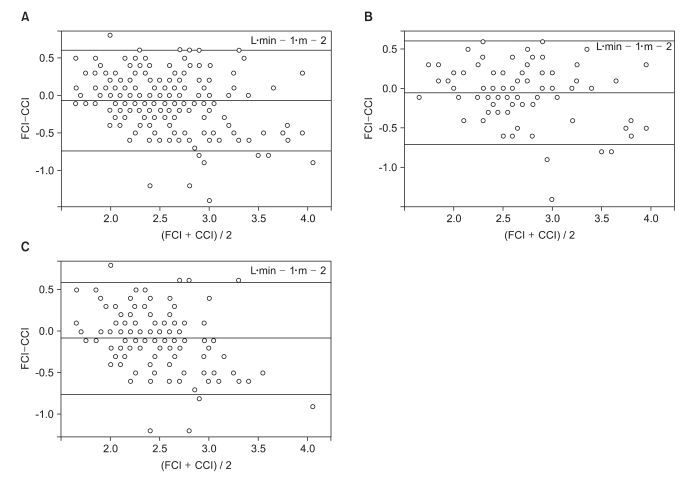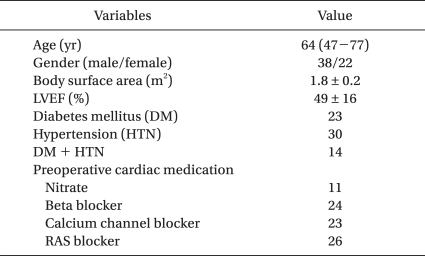1. Jhanji S, Dawson J, Pearse RM. Cardiac output monitoring: basic science and clinical application. Anaesthesia. 2008; 63:172–181. PMID:
18211449.

2. Sandham JD, Hull RD, Brant RF, Knox L, Pineo GF, Doig CJ, et al. Canadian Critical Care Clinical Trials Group. A randomized, controlled trial of the use of pulmonary-artery catheters in high-risk surgical patients. N Engl J Med. 2003; 348:5–14. PMID:
12510037.
3. Manecke GR. Edwards FloTrac sensor and Vigileo monitor: easy, accurate, reliable cardiac output assessment using the arterial pulse wave. Expert Rev Med Devices. 2005; 2:523–527. PMID:
16293062.

4. Sander M, Spies CD, Grubitzsch H, Foer A, Müller M, von Heymann C. Comparison of uncalibrated arterial waveform analysis in cardiac surgery patients with thermodilution cardiac output measurements. Crit Care. 2006; 10:R164. PMID:
17118186.
5. Mayer J, Boldt J, Schöllhorn T, Röhm KD, Mengistu AM, Suttner S. Semi-invasive monitoring of cardiac output by a new device using arterial pressure waveform analysis: a comparison with intermittent pulmonary artery thermodilution in patients undergoing cardiac surgery. Br J Anaesth. 2007; 98:176–182. PMID:
17218375.
6. de Waal EE, Kalkman CJ, Rex S, Buhre WF. Validation of a new arterial pulse contour-based cardiac output device. Crit Care Med. 2007; 35:1904–1909. PMID:
17581493.

7. Manecke GR Jr, Auger WR. Cardiac output determination from the arterial pressure wave: clinical testing of a novel algorithm that does not require calibration. J Cardiothorac Vasc Anesth. 2007; 21:3–7. PMID:
17289472.

8. Button D, Weibel L, Reuthebuch O, Genoni M, Zollinger A, Hofer CK. Clinical evaluation of the FloTrac/Vigileo system and two established continuous cardiac output monitoring devices in patients undergoing cardiac surgery. Br J Anaesth. 2007; 99:329–336. PMID:
17631509.
9. Mayer J, Boldt J, Wolf MW, Lang J, Suttner S. Cardiac output derived from arterial pressure waveform analysis in patients undergoing cardiac surgery: validity of a second generation device. Anesth Analg. 2008; 106:867–872. PMID:
18292432.
10. Mehta Y, Chand RK, Sawhney R, Bhise M, Singh A, Trehan N. Cardiac output monitoring: comparison of a new arterial pressure waveform analysis to the bolus thermodilution technique in patients undergoing off-pump coronary artery bypass surgery. J Cardiothorac Vasc Anesth. 2008; 22:394–399. PMID:
18503927.

11. Bland JM, Altman DG. Statistical methods for assessing agreement between two methods of clinical measurement. Lancet. 1986; 1:307–310. PMID:
2868172.

12. Myles PS, Cui J. Using the Bland-Altman method to measure agreement with repeated measures. Br J Anaesth. 2007; 99:309–311. PMID:
17702826.
13. Critchley LA, Critchley JA. A meta-analysis of studies using bias and precision statistics to compare cardiac output measurement techniques. J Clin Monit Comput. 1999; 15:85–91. PMID:
12578081.
14. Østergaard M, Nielsen J, Nygaard E. Pulse contour cardiac output: an evaluation of the FloTrac method. Eur J Anaesthesiol. 2009; 26:484–489. PMID:
19436173.

15. Halvorsen PS, Espinoza A, Lundblad R, Cvancarova M, Hol PK, Fosse E, et al. Agreement between PiCCO pulse-contour analysis, pulmonal artery thermodilution and transthoracic thermodilution during off-pump coronary artery by-pass surgery. Acta Anaesthesiol Scand. 2006; 50:1050–1057. PMID:
16987335.

16. de Waal EE, Wappler F, Buhre WF. Cardiac output monitoring. Curr Opin Anaesthesiol. 2009; 22:71–77. PMID:
19295295.

17. Chakravarthy M, Rajeev S, Jawali V. Cardiac index value measurement by invasive, semi-invasive and non invasive techniques: a prospective study in postoperative off pump coronary artery bypass surgery patients. J Clin Monit Comput. 2009; 23:175–180. PMID:
19412657.

18. O'Rourke MF, Yaginuma T. Wave reflections and the arterial pulse. Arch Intern Med. 1984; 144:366–371. PMID:
6365010.
19. Chassot PG, van der Linden P, Zaugg M, Mueller XM, Spahn DR. Off-pump coronary artery bypass surgery: physiology and anaesthetic management. Br J Anaesth. 2004; 92:400–413. PMID:
14970136.
20. Biais M, Nouette-Gaulain K, Cottenceau V, Vallet A, Cochard JF, Revel P, et al. Cardiac output measurement in patients undergoing liver transplantation: pulmonary artery catheter versus uncalibrated arterial pressure waveform analysis. Anesth Analg. 2008; 106:1480–1486. PMID:
18420863.
21. Lorsomradee S, Lorsomradee SR, Cromheecke S, De Hert SG. Continuous cardiac output measurement: arterial pressure analysis versus thermodilution technique during cardiac surgery with cardiopulmonary bypass. Anaesthesia. 2007; 62:979–983. PMID:
17845647.

22. Lorsomradee S, Lorsomradee S, Cromheecke S, De Hert SG. Uncalibrated arterial pulse contour analysis versus continuous thermodilution technique: effects of alterations in arterial waveform. J Cardiothorac Vasc Anesth. 2007; 21:636–643. PMID:
17905266.

23. Watt TB Jr, Burrus CS. Arterial pressure contour analysis for estimating human vascular properties. J Appl Physiol. 1976; 40:171–176. PMID:
1248996.

24. Mihaljevic T, von Segesser LK, Tönz M, Leskosek B, Seifert B, Jenni R, et al. Continuous versus bolus thermodilution cardiac output measurements--a comparative study. Crit Care Med. 1995; 23:944–949. PMID:
7736755.

25. Hogue CW Jr, Rosenbloom M, McCawley C, Lappas DG. Comparison of cardiac output measurement by continuous thermodilution with electromagnetometry in adult cardiac surgical patients. J Cardiothorac Vasc Anesth. 1994; 8:631–635. PMID:
7880990.

26. Robin E, Costecalde M, Lebuffe G, Vallet B. Clinical relevance of data from the pulmonary artery catheter. Crit Care. 2006; 10(Suppl 3):S3. PMID:
17164015.
27. Lazor MA, Pierce ET, Stanley GD, Cass JL, Halpern EF, Bode RH Jr. Evaluation of the accuracy and response time of STAT-mode continuous cardiac output. J Cardiothorac Vasc Anesth. 1997; 11:432–436. PMID:
9187990.









 PDF
PDF Citation
Citation Print
Print



 XML Download
XML Download